 Ahh, the late ’80s. Big hair, boom boxes, slap bracelets, leg warmers, parachute pants, and the Rubik’s cube. Did I just throw you back? The ’80s had some of the best (and easily some of the worst) fads and trends in history. One the biggest growing trends coming into the decade was arcades and coin operated videogames. But by the end of the ’80s, arcades and videogame cabinets had dwindled in popularity, though still thriving. It was generating money, but just nowhere near what it had been in the late ’70s and the early years of the ’80s—the collapse of videogaming in 1983 and the over-saturation of poor quality games were the leading causes of the decline. Regardless of the still-popular arcade scene, the mid-to-late ’80s have been characterized as the “collapse” of the arcade industry due to revenue starting to rapidly decline.
Ahh, the late ’80s. Big hair, boom boxes, slap bracelets, leg warmers, parachute pants, and the Rubik’s cube. Did I just throw you back? The ’80s had some of the best (and easily some of the worst) fads and trends in history. One the biggest growing trends coming into the decade was arcades and coin operated videogames. But by the end of the ’80s, arcades and videogame cabinets had dwindled in popularity, though still thriving. It was generating money, but just nowhere near what it had been in the late ’70s and the early years of the ’80s—the collapse of videogaming in 1983 and the over-saturation of poor quality games were the leading causes of the decline. Regardless of the still-popular arcade scene, the mid-to-late ’80s have been characterized as the “collapse” of the arcade industry due to revenue starting to rapidly decline.
The one thing that survived the decline? Pinball machines.
It was around this time that popular movie titles and television shows were being licensed out to pinball companies to draw interest. Pinball machines continued to grow and were permanent fixtures in many public places; they weren’t just limited to arcades or other establishments dedicated to videogames.
With home videogame consoles seeing a rampant increase in popularity, it was only a matter of time that pinball-related games would be created for these consoles for consumers to enjoy at home without having to purchase a whole pinball machine. In fact, one of the NES launch titles was a game called Pinball. Primitive and bland, it only had two different play screens in the entire game.
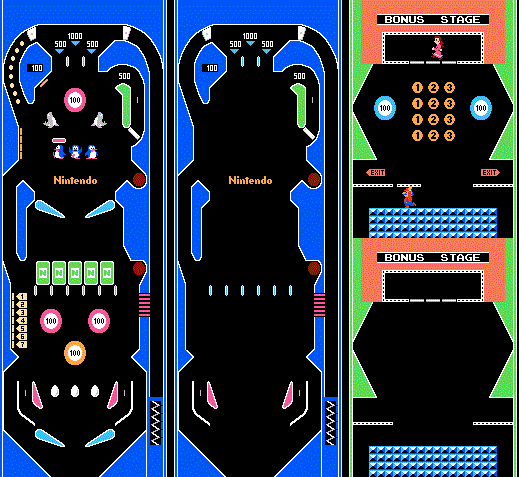 With one table variation, and one bonus stage, there was much to be desired.
With one table variation, and one bonus stage, there was much to be desired.
But it was the launch of the NES—having one table felt just like what the title to the game was. Just one table to play on, like it would be if you bought one actual pinball machine. The game had all of the basic fixtures you’d see in a normal pinball machine: Flippers, bumpers, spring-loaded plunger, tunnels, and targets to smash. It was basically your run of the mill pinball machine. There was nothing special about it to make it stand out, but it served it’s purpose.
As the NES library began to expand into the late ’80s and technology was being ramped up with each passing day, it was inevitable that a pinball game would be released on the NES that had several different tables and modes to choose from to give the player a variety. One game that really stood out in that department was Rock ‘n Ball.
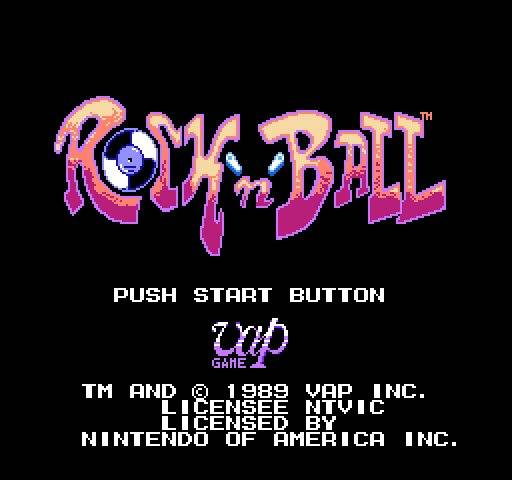 Gotta love that groovin’ record in the title.
Gotta love that groovin’ record in the title.
Released in 1990, Rock ‘n Ball was one of the first commercially available videogames in the pinball genre to feature multiple tables and modes to play on. The game has several different games to play: Pinball, Nineball, Battle Pinball, and Sports Pinball. Battle Pinball had three different tables to play on, and Sports Pinball had two variations to choose from. But it wasn’t just because it had variations that made it stand out. No, the reason it stood out was because all of the variations were designed remarkably well. That, and its knack for infuriating you to no end when playing against computer players or friends. Let it be known that the multiplayer modes can potentially be a lot of fun, if you’re not breaking every substance in your house to appease the beast this game will bring out of you.
The Pinball game is your normal pinball game: hit the targets across the table, shoot the ball up ramps and into tunnels to rack up the highest score you can until you lose all of your available balls. Completing certain tasks on the table would result in big points rewarded to the player. The high score system was also very different from what most were like at the time. Instead of having a preset list of high scores, you were competing against other computer players every time you played a game in this mode. At the end of your game, every player’s score would be listed and ranked from first to tenth. This gave the player incentive to do well; not only are you playing to get a high score, but you’re actively playing against someone else and have no idea what score you’ll have to beat to surpass them. Four players are able to play in this mode—when a player loses their ball, the next player will start their round, and this continues until all players have lost all of their balls. For a basic pinball game, this one is quite admirable. It’s a vibrant table with catchy music, and the addition of a lottery system on the top half of the table makes for an interesting spin.
In Nineball, the player is thrown into a gambling game of sorts. Playing on a Pachinko-like table, the player must shoot their balls into holes that are spread out across the board. Making a line of three in the middle or filling in the four corners would result in the player winning money based on how much they bet before the round started.
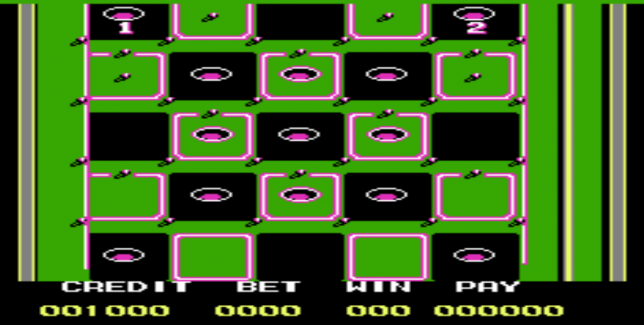 Playing field for Nineball. The numbers below holes indicate a multiplier if the player can make a line involving that hole.
Playing field for Nineball. The numbers below holes indicate a multiplier if the player can make a line involving that hole.
This game takes a considerable amount of skill to win effectively. The player must be able to hit the ball with their flippers into the holes they require to make a line, and to bypass the numerous pins that are placed to impede the ball’s path. The ability to shake the table to help steer the ball in your favor shines in this game, and will be a common tactic employed. Each player will find themselves thinking of when and where to hit their ball to give them the best shot of winning big on the board, and having to change their strategy entirely when a ball falls into a hole that was not intended. You are given 9 balls to try and make as many lines as possible to net you the biggest pay. The more holes you can fill up with the balls, even ones that you didn’t want or need, the better chance you’ll have of winning something. Each ball is precious so don’t let them go to waste! Play smart and play hard.
Are you sick of just playing against yourself for points? Want to put your skills to the test against the computer players? Maybe even cry in the corner when your now ex-friend schools you and laughs at your miserable being? These next two modes are right up your alley!
In Battle mode, you play one-on-one with a computer player or a friend. Each player is given a set of flippers in a top-down perspective. The object of the game: shoot the ball towards your opponent’s end of the table, get the ball past their flippers and out of play, resulting in a goal. A 3-game set, 5-game set, or 7-game set can be chosen to determine the length of the match. A game is decided when one player reaches 3 goals. There is also a very unique twist to this mode: each player can detach one of their flippers from their side of the table and move it to their opponent’s side in an attempt to shoot the ball passed their flippers, as well as provide an extra obstacle for the opposing player to shoot around.
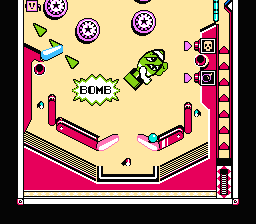 The blue flipper in the top-left corner sits in it’s place, waiting for the perfect moment to strike.
The blue flipper in the top-left corner sits in it’s place, waiting for the perfect moment to strike.
Battle mode invokes the most strategy-based playing this game has to offer: not only can you move your flippers to help you score, but the three different tables in this mode have gimmicks placed about that can either help or hinder your progress. You can’t take your eye off the action for even a single moment. If you do, your opponent will be one point closer to victory, and you’ll be throwing your controller in anger.
The fourth and final mode available is Sports Pinball. The player has a choice between Soccer and Hockey variations. Though both are very similar in presentation, they have their own unique twists to keep them apart.
In Soccer, each player controls the goalie on their side, and a flipper in front of their opponent’s goal. As the name implies, the object of this mode is to score on your opponent’s goalie to score a point. Both the goalie and the flipper can be moved horizontally by the player; the goalie can only move the length of the goal while the flipper can move the width of the entire table. The flipper can spin a full 360 degrees, with the A and B buttons being used to spin the flipper in different directions. In the corners on both ends are holes that act as corner kicks when the ball lands there while in play. The shooting player on that end can choose when to release the ball and form a strategy for their next shot on the goal.
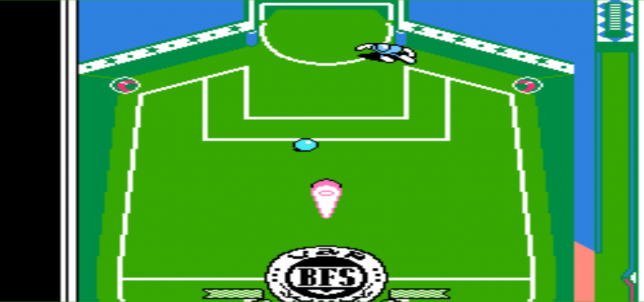 I don’t know about you, but that goalie looks like he’s about to lose his job.
I don’t know about you, but that goalie looks like he’s about to lose his job.
Unfortunately you cannot fake your injuries or slide tackle your opponent. The good people at VAP Inc. must have thought it wouldn’t be a good aspect to add. I vehemently disagree.
The requirements to win are the same as Battle mode: first player to 3 goals wins the game while playing in a 3-game, 5-game, or 7-game match.
Hockey mode is very similar to that of Soccer, but there are some notable differences: the goal is situated further away from the top/bottom of the playing field (like real hockey), the goalie can move further horizontally (nearly across the entire width of the playing field), and there are bumpers at the very top/bottom of the screen to keep the ball in play. No corner kick-like holes are present in this mode. Sadly there are no fights in Hockey mode, so make sure you throw down with your friend when things get heated. You know, to keep it realistic!
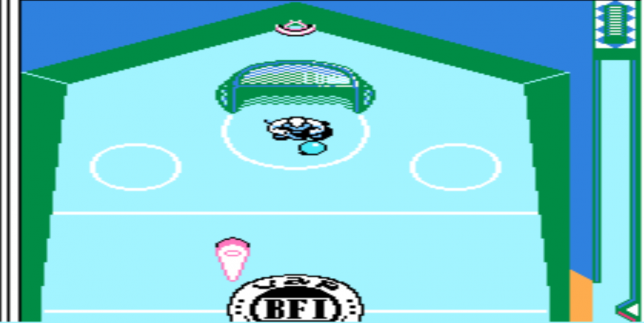 What do you mean “ice isn’t light blue”? Then what do you call this?
What do you mean “ice isn’t light blue”? Then what do you call this?
Graphically, this game is pretty outstanding. The NES color palette is used extensively to bring a very vibrant experience for the eye. The goalies in the sports modes are detailed fairly and you can clearly tell what you’re moving. The shadow effects around the goalies, the net, and other objects through each mode gives it a sense of realism and overall makes it look quite pleasant. Animations for the flippers are very smooth and don’t feel clunky at all for a game that’s over twenty years old. However, because the head-to-head tables are supposed to look like each side is on a slanted plane, the lines for the table running vertically look jagged and very coarse (as seen in the screenshot for Soccer). Some tables have a decent amount of detail, but the Soccer and Hockey modes leave a little bit to be desired.
The audio quality isn’t anything to shake a stick at, but each mode does come with its own original song. It gets repetitive, especially during matches that last a long time—each song is not exactly long and will loop often. That’s okay, because the mute button was invented for a reason! The sound effects of the flippers and ball bouncing around are stock quality, but the sound of your flipper smacking the ball in Soccer of Hockey is just so damn satisfying when you score with it. THWACK.
The most refined section of the game is easily the gameplay and the physics. Rock ‘n Ball‘s physics are bar none compared to other games from its time. From the direction the ball takes relative to where and when you hit it with your flipper, to the pins in Nineball making just about every launch a completely unique situation, the physics engine is outstanding. It does have its share of problems though; for instance, the ball can get stuck on rounded or slightly slanted platforms where logic would dictate the ball to fall. There’s also a glitch I recorded about a year ago in which the ball gets stuck between two targets and racks up an infinite amount of points. You can check it out here.
For the gameplay, this game has so much to offer in so many different scenarios: you can play alone and rack up as many points as possible, you can gamble by using strategy, you can battle against a computer player or a friend in a bout of skill, and you can play sports variants to your preference. Not to mention that all modes have the option of multiplayer (with Pinball and Nineball able to hold four players), this game offers a nice party-like atmosphere to the NES library. It can get boring with repeated play like most games, and that may be one of the only real flaws this game has.
Best of all, you don’t have to be a pinball fan to enjoy this game to its fullest extent. The advent of multiplayer to the pinball scene took something that is normally viewed as a single player activity and threw a big ol’ curveball at it, and about 37 years after the first two-player pinball machine was created in the real world, Rock ‘n Ball took that experience and made it incredibly enjoyable for people sitting in front of their television sets.
Before I leave, here is a list of things to remember when you’re playing the game. These are definitely not based off of personal experience. Nope.
- Do not curse at the computer player. This does nothing. They cannot hear you.
- Screaming “this is horse %&@#” when you’re losing will only make you play worse.
- Wrapping your controller cords around your opponents neck when they beat you does not make the situation better. The back seats of police cars are not comfy.
- As tempting as it seems, do not chuck your Rock ‘n Ball cartridge at a solid surface in a fit of rage.
- Do not be a poor sport. If you are losing, do not turn the game off and insult your opponent’s mother.
- If you unleash the Hulk deep inside you, keep casualties to a minimum.
- Make sure you have a kitten or puppy nearby to pet when you are angry. Puppies and kittens are the leading cure of anger.
If you can follow the list accordingly, your experience with Rock ‘n Ball should be nothing but great times and perfect memories!*
* It probably won’t.
Special Thanks: VAP Inc., Namco, and NTVIC for developing and publishing this game; GameCola; Nintendo for making very sturdy controllers.

you weren’t even alive in the 80s, dont pretend like its some throwback
I don’t think I ever claimed to have been born during that time period…